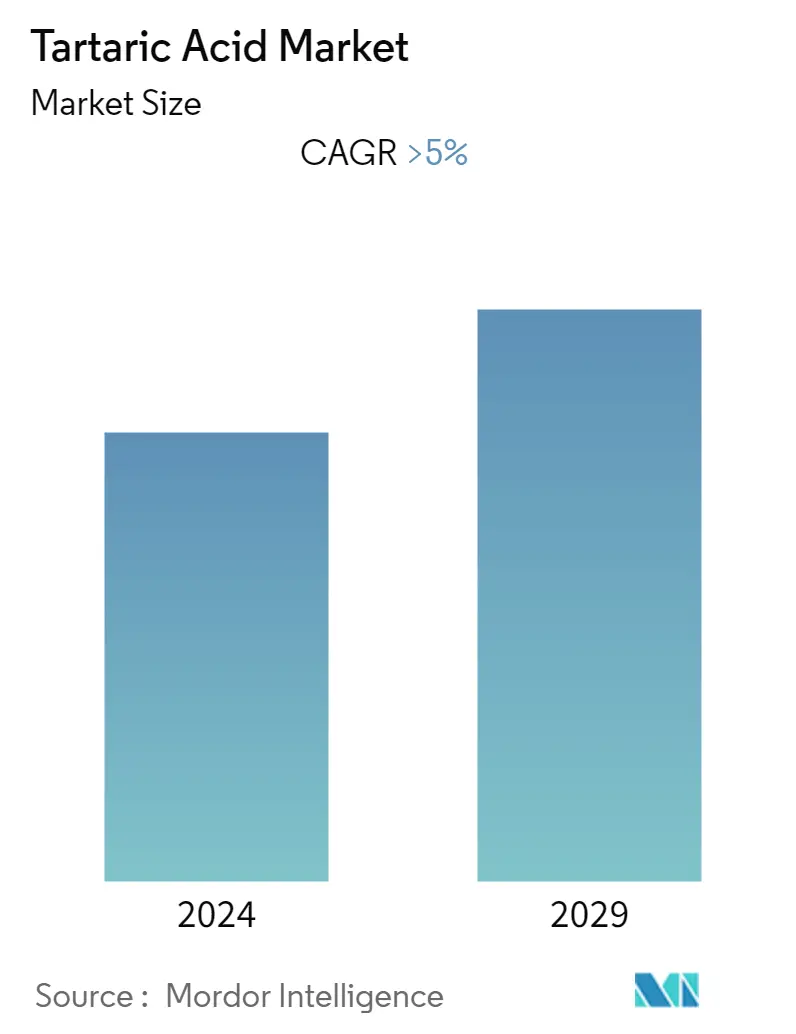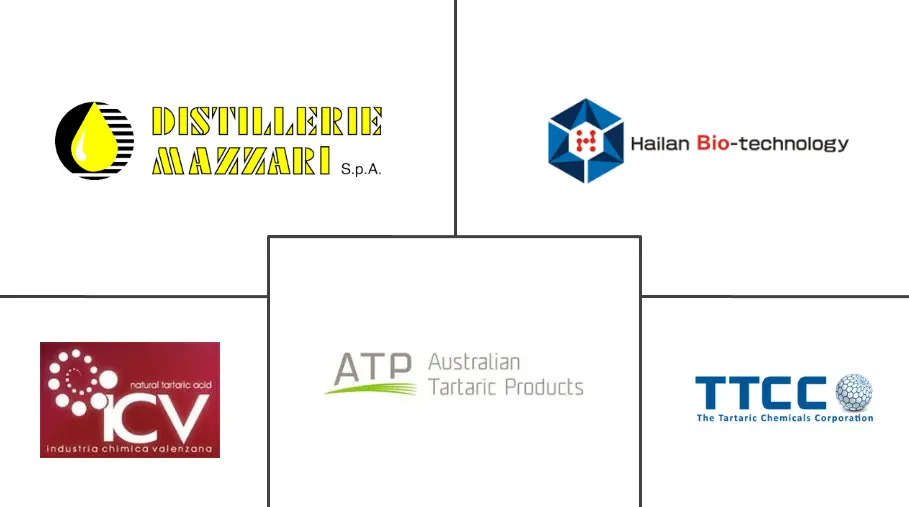Market Size of Tartaric Acid Industry

| Study Period | 2019 - 2029 |
| Base Year For Estimation | 2023 |
| CAGR | 5.00 % |
| Fastest Growing Market | Asia Pacific |
| Largest Market | Asia Pacific |
| Market Concentration | Low |
Major Players
*Disclaimer: Major Players sorted in no particular order |
Tartaric Acid Market Analysis
The market for tartaric acid is projected to register a CAGR of more than 5% during the forecast period.
COVID-19 impacted various industries, affecting the tartaric acid industry growth in 2020. However, the surging construction activities post-pandemic propelled the overall industry growth.
- Over the long term, the significant factors driving the studied market growth are increased microencapsulation adoption across pharmaceuticals and food industries and rising demand from the pharmaceutical industry.
- Increasing government regulations for restricting synthetic tartaric acid use in the food industry will likely hinder the market growth.
- Adopting tartaric acid in niche applications will likely create opportunities for the market in the coming years.
- The Asia-Pacific region is expected to dominate the tartaric acid market and will likely witness the highest CAGR during the forecast period.
Tartaric Acid Industry Segmentation
Tartaric acid is a strong dicarboxylic acid of plant origin. It is a white, crystalline organic acid that occurs naturally in fruits such as grapes, tamarinds, citrus, etc. The tartaric acid market is segmented by type, application, and end-user industries. The market is segmented by type into natural and synthetic tartaric acid. By application, the market is segmented into preservative and additive, laxative, intermediate, and other applications. By end-user industry, the market is segmented into food and beverage, pharmaceutical, cosmetics, construction, and other end-user industries. The report also covers the market size and forecasts for the Tartaric Acid market in 16 countries across major regions. The market sizing and forecasts for each segment are based on volume (kilo tons).
| Type | |
| Natural Tartaric Acid | |
| Synthetic Tartaric Acid |
| Application | |
| Preservative and Additive | |
| Laxative | |
| Intermediate | |
| Other Applications |
| End-user Industry | |
| Food and Beverage | |
| Pharmaceutical | |
| Cosmetics | |
| Construction | |
| Other End-user Industries |
| Geography | ||||||||
| ||||||||
| ||||||||
| ||||||||
| ||||||||
|
Tartaric Acid Market Size Summary
The tartaric acid market is poised for significant growth, driven by increased adoption in microencapsulation within the pharmaceuticals and food industries, alongside rising demand from the pharmaceutical sector. The market's expansion is further supported by the resurgence of construction activities post-COVID-19, which has bolstered overall industry growth. However, the market faces challenges due to increasing government regulations aimed at restricting the use of synthetic tartaric acid in food applications. Despite these challenges, the market is expected to benefit from opportunities in niche applications. The Asia-Pacific region is anticipated to lead the market, with the highest growth rate, supported by robust demand from countries like China and India, which are key consumers in the food, beverage, and pharmaceutical sectors.
In the cosmetics and personal care industry, tartaric acid is utilized as a pH adjuster and antioxidant, contributing to its moderate growth within this segment. The personal care market, particularly in Asia-Pacific, is expanding due to rising awareness of personal care and grooming, especially among male consumers. This growth is further fueled by the region's dominance in the global beauty and personal care market, with China emerging as a major player. The Indian cosmetics and personal care sector is also experiencing rapid growth, offering significant market entry potential for international companies. The fragmented nature of the tartaric acid market includes key players such as Distillerie Mazzari S.p.A, AUSTRALIAN TARTARIC PRODUCTS, and Anhui Hailan Biotechnology Co. Ltd, among others, indicating a competitive landscape with ongoing developments.
Tartaric Acid Market Size - Table of Contents
-
1. MARKET DYNAMICS
-
1.1 Drivers
-
1.1.1 Growing Demand for Wine in the Asia-Pacific and Latin American Regions
-
1.1.2 Increased Adoption of Microencapsulation across Pharmaceuticals and Food Industries
-
1.1.3 Rising Demand from the Pharmaceutical Industry
-
-
1.2 Restraints
-
1.2.1 Increasing Government Regulations for Restricted Use of Synthetic Tartaric Acid in the Food Industry
-
-
1.3 Industry Value-Chain Analysis
-
1.4 Porter's Five Forces Analysis
-
1.4.1 Bargaining Power of Suppliers
-
1.4.2 Bargaining Power of Consumers
-
1.4.3 Threat of New Entrants
-
1.4.4 Threat of Substitute Products and Services
-
1.4.5 Degree of Competition
-
-
-
2. MARKET SEGMENTATION (Market Size in Volume)
-
2.1 Type
-
2.1.1 Natural Tartaric Acid
-
2.1.2 Synthetic Tartaric Acid
-
-
2.2 Application
-
2.2.1 Preservative and Additive
-
2.2.2 Laxative
-
2.2.3 Intermediate
-
2.2.4 Other Applications
-
-
2.3 End-user Industry
-
2.3.1 Food and Beverage
-
2.3.2 Pharmaceutical
-
2.3.3 Cosmetics
-
2.3.4 Construction
-
2.3.5 Other End-user Industries
-
-
2.4 Geography
-
2.4.1 Asia-Pacific
-
2.4.1.1 China
-
2.4.1.2 India
-
2.4.1.3 Japan
-
2.4.1.4 South Korea
-
2.4.1.5 Rest of Asia-Pacific
-
-
2.4.2 North America
-
2.4.2.1 United States
-
2.4.2.2 Canada
-
2.4.2.3 Mexico
-
-
2.4.3 Europe
-
2.4.3.1 Germany
-
2.4.3.2 United Kingdom
-
2.4.3.3 France
-
2.4.3.4 Italy
-
2.4.3.5 Spain
-
2.4.3.6 Rest of Europe
-
-
2.4.4 South America
-
2.4.4.1 Brazil
-
2.4.4.2 Argentina
-
2.4.4.3 Rest of South America
-
-
2.4.5 Middle-East and Africa
-
2.4.5.1 Saudi Arabia
-
2.4.5.2 South Africa
-
2.4.5.3 Rest of Middle-East and Africa
-
-
-
Tartaric Acid Market Size FAQs
What is the current Tartaric Acid Market size?
The Tartaric Acid Market is projected to register a CAGR of greater than 5% during the forecast period (2024-2029)
Who are the key players in Tartaric Acid Market?
Anhui hailan bio-technology co., LD, Distillerie Mazzari S.p.A. , Industria Chimica Valenzana I.C.V. SpA, AUSTRALIAN TARTARIC PRODUCTS and The Tartaric Chemicals Corporation are the major companies operating in the Tartaric Acid Market.

